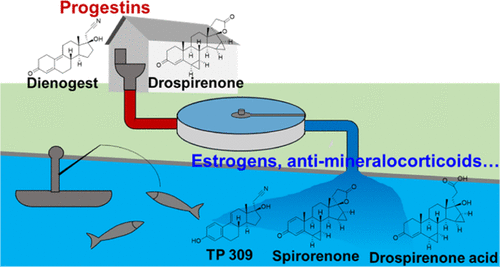当前位置:
X-MOL 学术
›
Environ. Sci. Technol.
›
论文详情
Our official English website, www.x-mol.net, welcomes your
feedback! (Note: you will need to create a separate account there.)
Biotransformation of Current-Use Progestin Dienogest and Drospirenone in Laboratory-Scale Activated Sludge Systems Forms High-Yield Products with Altered Endocrine Activity
Environmental Science & Technology ( IF 10.8 ) Pub Date : 2021-09-28 , DOI: 10.1021/acs.est.1c03805 Haoqi Nina Zhao 1, 2 , Zhenyu Tian 2, 3 , Kelly E Kim 3 , Rui Wang 1, 2 , Kenji Lam 1 , Edward P Kolodziej 1, 2, 3
Environmental Science & Technology ( IF 10.8 ) Pub Date : 2021-09-28 , DOI: 10.1021/acs.est.1c03805 Haoqi Nina Zhao 1, 2 , Zhenyu Tian 2, 3 , Kelly E Kim 3 , Rui Wang 1, 2 , Kenji Lam 1 , Edward P Kolodziej 1, 2, 3
Affiliation

|
Dienogest (DIE) and drospirenone (DRO) are two fourth-generation synthetic progestins widely used as oral contraceptives. Despite their increasing detection in wastewaters and surface waters, their fate during biological wastewater treatment is unclear. Here, we investigated DIE and DRO biotransformation with representative activated sludge batch incubations and identified relevant transformation products (TPs) using high-resolution mass spectrometry. DIE exhibited slow biotransformation (16–30 h half-life) and proceeded through a quantitative aromatic dehydrogenation to form TP 309 (molar yields of ∼55%), an aromatic TP ∼30% estrogenic as 17β-estradiol. DRO experienced more rapid biotransformation (<0.5 h half-life), and 1,2-dehydrogenation formed the major TP 364 (molar yields of ∼40%), an antimineralocorticoid drug candidate named as spirorenone. Lactone ring hydrolysis was another important biotransformation pathway for DRO (molar yields of ∼20%) and generated pharmacologically inactive TP 384. Other minor pathways for DIE and DRO included hydroxylation, methoxylation, and 3-keto and C4(5) double-bond hydrogenation; distinct bioactivities are plausible for such TPs, including antigestagenic activity, antigonadotropic activity, and pregnancy inhibition effects. Thus, biotransformation products of DIE and DRO during wastewater treatment should be considered in environmental assessments of synthetic progestins, especially certain TPs such as the estrogenic TP 309 of DIE and the antimineralocorticoid spirorenone (TP 364) of DRO.
中文翻译:

当前使用的孕激素地诺孕素和屈螺酮在实验室规模的活性污泥系统中的生物转化形成具有改变内分泌活性的高产产品
地诺孕素 (DIE) 和屈螺酮 (DRO) 是两种广泛用作口服避孕药的第四代合成孕激素。尽管它们在废水和地表水中的检测越来越多,但它们在废水生物处理过程中的命运尚不清楚。在这里,我们通过具有代表性的活性污泥分批孵化研究了 DIE 和 DRO 生物转化,并使用高分辨率质谱法鉴定了相关的转化产物 (TP)。DIE 表现出缓慢的生物转化(16-30 小时半衰期)并通过定量芳烃脱氢形成 TP 309(摩尔产率约 55%),芳烃 TP 约 30% 雌激素,如 17β-雌二醇。DRO 经历了更快速的生物转化(<0.5 小时半衰期),1,2-脱氢形成了主要的 TP 364(摩尔产率约为 40%),一种名为螺酮的抗盐皮质激素候选药物。内酯环水解是 DRO 的另一个重要生物转化途径(摩尔产率约为 20%)并生成无药理活性的 TP 384。 DIE 和 DRO 的其他次要途径包括羟基化、甲氧基化以及 3-酮和 C4(5) 双键氢化; 此类 TP 具有独特的生物活性,包括抗妊娠活性、抗促性腺激素活性和妊娠抑制作用。因此,在合成孕激素的环境评估中应考虑废水处理过程中 DIE 和 DRO 的生物转化产物,尤其是某些 TP,如 DIE 的雌激素 TP 309 和 DRO 的抗盐皮质激素螺酮 (TP 364)。内酯环水解是 DRO 的另一个重要生物转化途径(摩尔产率约为 20%)并生成无药理活性的 TP 384。 DIE 和 DRO 的其他次要途径包括羟基化、甲氧基化以及 3-酮和 C4(5) 双键氢化; 此类 TP 具有独特的生物活性,包括抗妊娠活性、抗促性腺激素活性和妊娠抑制作用。因此,在合成孕激素的环境评估中应考虑废水处理过程中 DIE 和 DRO 的生物转化产物,尤其是某些 TP,如 DIE 的雌激素 TP 309 和 DRO 的抗盐皮质激素螺酮 (TP 364)。内酯环水解是 DRO 的另一个重要生物转化途径(摩尔产率约为 20%)并生成无药理活性的 TP 384。 DIE 和 DRO 的其他次要途径包括羟基化、甲氧基化以及 3-酮和 C4(5) 双键氢化; 此类 TP 具有独特的生物活性,包括抗妊娠活性、抗促性腺激素活性和妊娠抑制作用。因此,在合成孕激素的环境评估中应考虑废水处理过程中 DIE 和 DRO 的生物转化产物,尤其是某些 TP,如 DIE 的雌激素 TP 309 和 DRO 的抗盐皮质激素螺酮 (TP 364)。和3-酮和C4(5)双键氢化;此类 TP 具有独特的生物活性,包括抗妊娠活性、抗促性腺激素活性和妊娠抑制作用。因此,在合成孕激素的环境评估中应考虑废水处理过程中 DIE 和 DRO 的生物转化产物,尤其是某些 TP,例如 DIE 的雌激素 TP 309 和 DRO 的抗盐皮质激素螺酮 (TP 364)。和3-酮和C4(5)双键氢化;此类 TP 具有独特的生物活性,包括抗妊娠活性、抗促性腺激素活性和妊娠抑制作用。因此,在合成孕激素的环境评估中应考虑废水处理过程中 DIE 和 DRO 的生物转化产物,尤其是某些 TP,如 DIE 的雌激素 TP 309 和 DRO 的抗盐皮质激素螺酮 (TP 364)。
更新日期:2021-10-19
中文翻译:

当前使用的孕激素地诺孕素和屈螺酮在实验室规模的活性污泥系统中的生物转化形成具有改变内分泌活性的高产产品
地诺孕素 (DIE) 和屈螺酮 (DRO) 是两种广泛用作口服避孕药的第四代合成孕激素。尽管它们在废水和地表水中的检测越来越多,但它们在废水生物处理过程中的命运尚不清楚。在这里,我们通过具有代表性的活性污泥分批孵化研究了 DIE 和 DRO 生物转化,并使用高分辨率质谱法鉴定了相关的转化产物 (TP)。DIE 表现出缓慢的生物转化(16-30 小时半衰期)并通过定量芳烃脱氢形成 TP 309(摩尔产率约 55%),芳烃 TP 约 30% 雌激素,如 17β-雌二醇。DRO 经历了更快速的生物转化(<0.5 小时半衰期),1,2-脱氢形成了主要的 TP 364(摩尔产率约为 40%),一种名为螺酮的抗盐皮质激素候选药物。内酯环水解是 DRO 的另一个重要生物转化途径(摩尔产率约为 20%)并生成无药理活性的 TP 384。 DIE 和 DRO 的其他次要途径包括羟基化、甲氧基化以及 3-酮和 C4(5) 双键氢化; 此类 TP 具有独特的生物活性,包括抗妊娠活性、抗促性腺激素活性和妊娠抑制作用。因此,在合成孕激素的环境评估中应考虑废水处理过程中 DIE 和 DRO 的生物转化产物,尤其是某些 TP,如 DIE 的雌激素 TP 309 和 DRO 的抗盐皮质激素螺酮 (TP 364)。内酯环水解是 DRO 的另一个重要生物转化途径(摩尔产率约为 20%)并生成无药理活性的 TP 384。 DIE 和 DRO 的其他次要途径包括羟基化、甲氧基化以及 3-酮和 C4(5) 双键氢化; 此类 TP 具有独特的生物活性,包括抗妊娠活性、抗促性腺激素活性和妊娠抑制作用。因此,在合成孕激素的环境评估中应考虑废水处理过程中 DIE 和 DRO 的生物转化产物,尤其是某些 TP,如 DIE 的雌激素 TP 309 和 DRO 的抗盐皮质激素螺酮 (TP 364)。内酯环水解是 DRO 的另一个重要生物转化途径(摩尔产率约为 20%)并生成无药理活性的 TP 384。 DIE 和 DRO 的其他次要途径包括羟基化、甲氧基化以及 3-酮和 C4(5) 双键氢化; 此类 TP 具有独特的生物活性,包括抗妊娠活性、抗促性腺激素活性和妊娠抑制作用。因此,在合成孕激素的环境评估中应考虑废水处理过程中 DIE 和 DRO 的生物转化产物,尤其是某些 TP,如 DIE 的雌激素 TP 309 和 DRO 的抗盐皮质激素螺酮 (TP 364)。和3-酮和C4(5)双键氢化;此类 TP 具有独特的生物活性,包括抗妊娠活性、抗促性腺激素活性和妊娠抑制作用。因此,在合成孕激素的环境评估中应考虑废水处理过程中 DIE 和 DRO 的生物转化产物,尤其是某些 TP,例如 DIE 的雌激素 TP 309 和 DRO 的抗盐皮质激素螺酮 (TP 364)。和3-酮和C4(5)双键氢化;此类 TP 具有独特的生物活性,包括抗妊娠活性、抗促性腺激素活性和妊娠抑制作用。因此,在合成孕激素的环境评估中应考虑废水处理过程中 DIE 和 DRO 的生物转化产物,尤其是某些 TP,如 DIE 的雌激素 TP 309 和 DRO 的抗盐皮质激素螺酮 (TP 364)。


















































 京公网安备 11010802027423号
京公网安备 11010802027423号